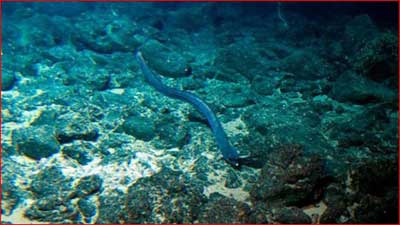Date: 29/04/2023
Relevance: GS-3: Biodiversity and Environment
Key Phrases: echo sounders, altimetry, CryoSat-2, Envisat, SARAL, Guyots, Fracture zone seamounts, Volcanic chain seamounts, Ocean circulation, Jason-1 geodetic.
Context:
- Scientists have recently discovered 19,325 new seamounts through new high-resolution data.
- A 2011 census had already mapped 24,000 seamounts across the world's oceans.
How was the discovery made?
- Surveyors map seamounts using one of two modes – echo sounders or multibeam sonar on ships for topographic mapping or using satellite altimetry for gravity-field mapping.
- Research vessels with multibeam sonar mapping produce hi-res maps but these maps are often incomplete: the places where the vessels don’t go become blindspots.
- In satellite altimetry, a satellite uses radar to gauge the shape of the seafloor by measuring the time taken for each pulse to bounce off the ground and return. The resulting maps are low-res but have much better coverage.
- Since the 2011 seamount survey, altimetry has improved in two key
ways.
- Firstly, the European Space Agency launched CryoSat-2 and Envisat, and NASA and the French space agency jointly launched the Jason-1 geodetic missions. These missions helped to achieve improved spatial coverage.
- Secondly, SARAL, a satellite developed by India and France for oceanographic studies, made a significant contribution by further reducing radar noise and enabling the expansion of the seamount catalog.
- Recently, scientists from Scripps Institution of Oceanography, Chungnam National University, and the University of Hawaii at Manoa reported discovering over 19,000 new seamounts using advancements in altimetry for gravity-field mapping.

What are Seamounts?
- Seamounts are underwater mountains rising from the ocean floor. They are typically conical or dome-shaped, and can range in height from a few hundred meters to several kilometers.
- Seamounts are formed by volcanic activity, with the eruptions occurring under the ocean's surface.
- Seamount formation starts with a hotspot, which is an area of volcanic activity beneath the Earth's crust.
- When the Earth's tectonic plates move over the hotspot, the rising magma can eventually reach the surface and erupt as lava.
- As the lava cools, it solidifies and forms a new layer of rock on top of the seafloor.
- Over time, the repeated eruptions can build up the seamount until it reaches the surface of the ocean.
- Like volcanoes on land, seamounts can be active, extinct or dormant volcanoes.
- Most seamounts are formed near mid-ocean ridges, where the earth’s tectonic plates are moving apart, allowing molten rock to rise to the seafloor.
- The planet’s two most-studied mid-ocean ridges are the Mid-Atlantic Ridge and the East Pacific Rise.
- Some seamounts have also been found near intraplate hotspots – regions of heavy volcanic activity within a plate – and oceanic island chains with the volcanic and seismic activity called island arcs.
Do you know?
- The highest mountain on Earth is actually a seamount—Hawaii’s Mauna Kea, a dormant volcano that is more than 30,000 feet tall measured from its base on the seafloor 18,000 feet beneath the surface.
There are several different types of seamounts, including:
- Submarine Seamounts: These are seamounts that are entirely underwater and do not reach the ocean's surface.
- Guyots: Also known as tablemounts, guyots are seamounts with flat tops that have been eroded by wave action. Guyots are thought to have once been active seamounts that have since sunk to a depth where they are no longer volcanically active.
- Fracture zone seamounts: These seamounts are formed at the intersection of two tectonic plates, where the crust is being pulled apart. The resulting fractures provide a pathway for magma to reach the surface and form a seamount.
- Hotspot seamounts: These seamounts are formed when a tectonic plate moves over a hotspot in the Earth's mantle. The hotspot melts the plate above it, creating a plume of magma that rises to the surface and forms a volcano.
- Volcanic chain seamounts: These seamounts are formed by a chain of volcanoes that form over time as a tectonic plate moves over a hotspot. As the plate moves, new volcanoes form, creating a chain of seamounts.

Significance of Seamounts:
- Biodiversity:
- They are good places for life because they can cause localised ocean upwelling – the process by which nutrient-rich water from deep within the ocean moves up to the surface.
- Seamounts are hotspots of marine biodiversity, providing unique habitats for a variety of species, some of which are found nowhere else on Earth.
- Many species of fish, invertebrates, and corals rely on seamounts for food, shelter, and breeding grounds.
- Ocean circulation:
- Seamounts can influence ocean circulation by altering the flow of currents and eddies.
- They can also create turbulence, which can mix different layers of water and nutrients, benefiting marine life.
- Geological research:
- Seamounts provide valuable insights into the Earth's geology, as they are formed by volcanic activity.
- By studying seamounts, scientists can learn about the formation and evolution of the Earth's crust, as well as the composition of the ocean floor.
- Economic value:
- Seamounts are also of economic value as they may contain valuable minerals, oil, and gas reserves.
- However, their exploitation must be done carefully to avoid damaging the delicate ecosystems that depend on them.
Conclusion:
- The discovery of over 19,000 new seamounts is a significant achievement in the field of oceanography.
- The advancement in technology, particularly in altimetry for gravity-field mapping, has allowed researchers to uncover these previously unknown underwater mountains.
- The information gathered from studying seamounts can provide valuable insights into the Earth's tectonic plates and their evolution, as well as the composition of the mantle.
Sources: The Hindu
Mains Question:
Q. Explain the formation of seamounts and their significance in understanding tectonic plate movement and mantle composition. (250 Words).






















